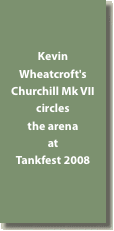
The Churchill was another result of the frantic pressure, post-Dunkirk, to replace the tanks lost in France. Based on an earlier specification for a heavy, ‘infantry’ tank, it went into production in June 1941, just 12 months after the revised specification had been issued.
The Churchill was another result of the frantic pressure, post-Dunkirk, to replace the tanks lost in France. Based on an earlier specification for a heavy, ‘infantry’ tank, it was first in production only 12 months after the revised specification had been issued, by June 1941. It was underpowered (although this was not as critical in an ‘infantry’ tank as in a ‘cruiser’), undergunned (a 2pdr) and riddled with mechanical problems which any less rushed development phase would have ironed out. However, it did have better protection than any other British tank to date, with the front being proof against almost anything up to 50mm, and later reinforced models beyond this.
Development continued with the tank in service. After the first 12 months or so, most of the mechanical issues had been rectified, and supplies of the 6pdr gun enabled a partial correction of the armament problem. Earlier attempts to strengthen the armament by building a 3” howitzer in the forward hull had been tried and abandoned. The Churchill’s first experience of combat was the ill-fated Dieppe raid in August 1942, where all the tanks were lost, some never making it off the beach. But this was not all down to the tank itself. Shortly after that a small number were shipped to North Africa where they took part in the Second Battle of Alamein, demonstrating the value of their thick armour and general durability. Thereafter more examples were shipped in and the Churchill figured significantly in Tunisia in 1943, and continued in Italy after that.
But the armament was still an issue. While the 6pdr was adequate against the Panzer IIIs and early IVs, later IVs and Tigers were beyond its capabilities. Some Churchills in North Africa were experimentally fitted with the 75mm gun from the Sherman and these provided some improvement. The move was standardised in the Mark VII with a 75mm gun in a new turret. This variant equipped a number of British formations during the invasion of Normandy in 1944 and beyond.
Although effectively replaced by 1945, the Churchill soldiered on in Korea and, in other guises, well into the 1950s. Specialist engineer vehicles such as bridge layers, mine clearers and recovery vehicles demonstrated the ability of the chassis. Perhaps the most successful (and long-lasting) version was the ‘crocodile’ – a flame thrower tank, with the BESA machine gun replaced by a flame gun, whose fuel was towed in an armoured trailer.
